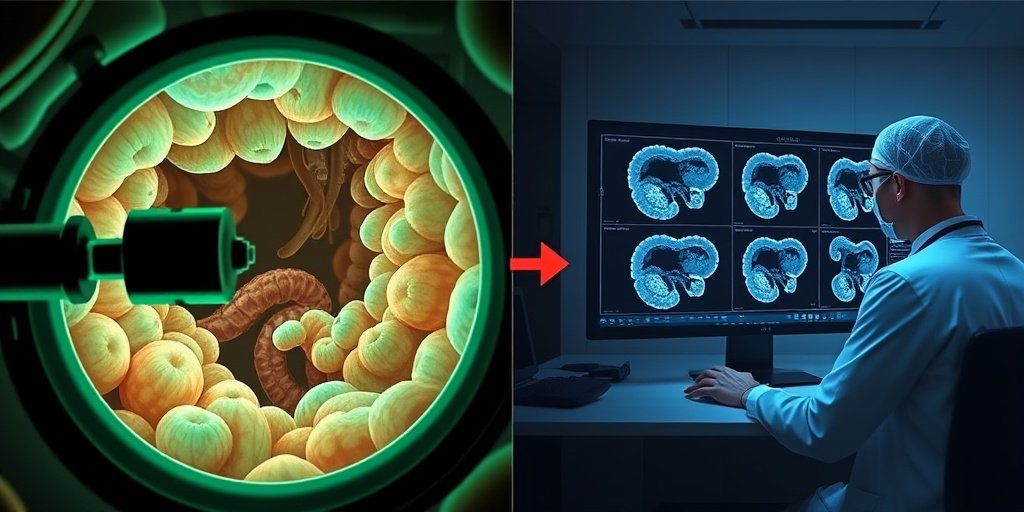⚡ Quick Summary
This study introduces MSFNet, a novel polyp image segmentation model that utilizes multi-scale contextual feature extraction and dual attention mechanisms to enhance the detection of early colon polyps. The model demonstrates impressive performance, achieving a Dice score of 0.892 and an mIoU of 0.926, significantly outperforming existing methods.
🔍 Key Details
- 📊 Dataset: CVC-ClinicDB
- 🧩 Features used: Polyp images
- ⚙️ Technology: MSFNet with MBDCK module
- 🏆 Performance: Dice score: 0.892, mIoU: 0.926
🔑 Key Takeaways
- 🔍 Early detection of colon polyps is crucial for preventing colorectal cancer.
- 💡 MSFNet employs multi-scale feature extraction and attention mechanisms for improved segmentation.
- 🏆 Outperforms U-Net by approximately 10% in mIoU.
- 🤖 MBDCK module enhances multi-scale context information and addresses the receptive field limitation.
- 📉 Fewer parameters are required compared to existing advanced segmentation methods.
- 🌍 The study’s findings could significantly impact colorectal cancer diagnosis and treatment.
- 🧪 Theoretical analysis supports the effectiveness of the proposed methods.

📚 Background
Colorectal cancer often arises from the malignant transformation of early colon polyps, which are typically benign. If left untreated, these polyps can progress to cancer, making early diagnosis essential for improving patient survival rates. Traditional methods of polyp detection can struggle with small polyp localization and unclear segmentation boundaries, necessitating innovative approaches in medical imaging.
🗒️ Study
The research team developed MSFNet, a polyp image segmentation model designed to tackle the challenges of detecting small polyps in medical images. By leveraging multi-scale contextual feature extraction and dual attention mechanisms, the model aims to enhance the accuracy of polyp localization and segmentation. The study utilized the CVC-ClinicDB dataset to evaluate the model’s performance against existing segmentation methods.
📈 Results
MSFNet achieved a Dice score of 0.892 and an mIoU of 0.926, demonstrating superior performance compared to U-Net and other advanced models like PraNet and SwinUNet. The model’s ability to maintain a low parameter count while delivering high accuracy is particularly noteworthy, indicating its potential for practical applications in clinical settings.
🌍 Impact and Implications
The findings from this study could revolutionize the early detection of colorectal cancer by providing a more accurate and efficient method for polyp segmentation. As early diagnosis is critical for improving patient outcomes, the implementation of MSFNet in clinical practice could lead to better screening processes and ultimately save lives. The integration of advanced machine learning techniques in medical imaging holds promise for enhancing diagnostic capabilities across various medical fields.
🔮 Conclusion
This study highlights the significant advancements in polyp image segmentation through the development of MSFNet. By utilizing innovative techniques such as multi-scale feature extraction and dual attention mechanisms, the model demonstrates remarkable accuracy and efficiency. The potential for such technologies to improve early detection of colorectal cancer is immense, paving the way for future research and applications in medical imaging.
💬 Your comments
What are your thoughts on the advancements in polyp image segmentation? We would love to hear your insights! 💬 Share your comments below or connect with us on social media:
Polyp image segmentation based on parallel dilated convolution and dual attention mechanisms.
Abstract
Colorectal cancer is usually caused by malignant transformation of early colon polyps. Early polyps are benign, but if left untreated, they can progress to cancer. Early diagnosis of polyps can significantly improve the survival rate of patients. To overcome the challenges of small polyp localization and the blurring of segmentation boundaries caused by indistinct polyp edges in existing research on colon cancer medical image diagnosis, we propose MSFNet (Muilti-Scale Feature Unet), a polyp image segmentation model using multi-scale contextual feature extraction and re-aggregation channel attention modules. MSFNet extracts detailed information separately from spatial and channel features, which can efficiently explore image details and help locate small polyp positions. Simultaneously using channel by channel convolution and dilated convolution while maintaining a low parameter count, MSFNet can achieving strong performance on small datasets. In addition, we propose MBDCK (Multi Scale Big Dilated Conv kernel) module, which consists of dilated large convolutions with different kernel sizes in parallel, to enhance the multi-scale context information and solve the limited receptive field problem. We design skip connections to fuse feature map information at multiple scales, which enhance the model’s ability to obtain global features and suppresses the extraction of irrelevant features. Theoretical analysis and extensive experimental results demonstrate that the method proposed in this paper, compared to existing advanced medical image segmentation methods, has fewer parameters while achieving excellent segmentation accuracy and generalization ability. On CVC-ClinicDB, MSFNet attains a Dice of 0.892 and an mIoU of 0.926, out-performing U-Net by about 10% in mIoU and surpassing recent advanced models such as PraNet and SwinUNet.
Author: [‘Chen S’, ‘Chen K’, ‘Wang C’, ‘Zhou Z’, ‘Wen S’, ‘Zhu T’, ‘Wu M’]
Journal: Neural Netw
Citation: Chen S, et al. Polyp image segmentation based on parallel dilated convolution and dual attention mechanisms. Polyp image segmentation based on parallel dilated convolution and dual attention mechanisms. 2025; 195:108282. doi: 10.1016/j.neunet.2025.108282